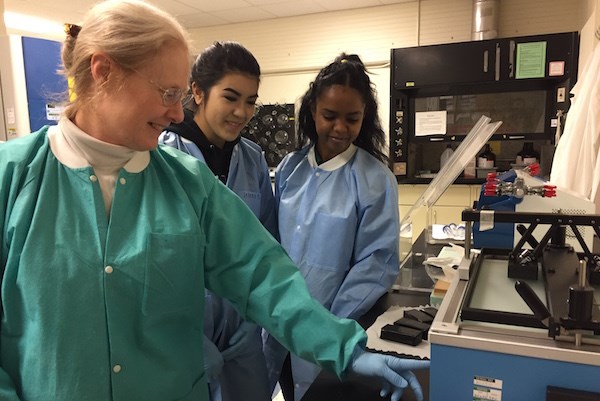Faculty Partner with Massachusetts Companies to Find Safer Alternatives

12/22/2016
By Karen Angelo
Here’s a fact that may surprise you: In 2013, Massachusetts manufacturers used more than 57 million pounds of methanol. The toxic alcohol, linked to reproduction and other health concerns, is found in products such as windshield washer fluid and used as industrial solvents in manufacturing.
Similarly, other products and manufacturing processes, ranging from disinfection solutions to laboratory testing devices, contain or use toxic chemicals.
With a goal of reducing toxics use while keeping Massachusetts businesses competitive, several researchers are exploring safer alternatives, thanks to grants from the Toxics Use Reduction Institute (TURI) at UMass Lowell. TURI recently awarded three research projects — two at UMass Lowell and one at UMass Amherst — approximately $20,000 each to look for safer substances.
Replacing a Toxic Used in Laboratory Testing Devices
Some laboratory testing products use surfactants, compounds that lower the surface tension between a liquid and another liquid or solid, that the European Chemicals Agency has listed as substances of very high concern.
This alert from the European agency prompted Siemens Healthcare Diagnostics in Norwood to seek assistance from TURI in looking for alternatives. With TURI funding last year, Prof. Ram Nagarajan of plastics engineering discovered new surfactants derived from sugar or pectin that could be used in Siemens’ immunoassay lab products. Under this year’s grant, Assoc. Prof. Peter Gaines of biology will test whether the new compounds are toxic to cells.
“Even though the new molecules may seem benign, the last thing we want to do is shift to a new substance that presents unintended consequences on health or the environment,” says Pam Eliason, industry research program manager at TURI. “This year’s research is unique to TURI in that these new substances will also be tested to determine the potential for human or ecological toxicity.”
Gaines is testing the compounds using three different human model cell types that represent the types of human tissues most likely to be exposed to toxic substances.
“We are adding different concentrations of the chemicals to cultures of each cell type and analyzing their survival, growth and metabolic profiles using high-throughput tools,” says Gaines. “The results will be benchmarked against the toxic detergents normally used in systems like those used by Siemens.”
Can Cleaning Products Also Disinfect?
Using disinfectants seems like the right idea when it comes to cleaning schools and hospitals, but the products often contain chlorine that can harm aquatic and land ecosystems as well as cause skin and eye irritation, asthma and other health issues.
“Janitorial workers are inhaling a toxic vapor that can cause serious health issues,” says Eliason. “But the disinfection product may not even be killing bacteria effectively, because the solution needs to sit for up to ten minutes on a surface to work, and this rarely happens.”
Partnering with Michael Glass, president of cleaning supplies distributor M.D. Stetson in Randolph, Assoc. Prof. Nancy Goodyear of biomedical and nutritional sciences will test the effectiveness of safer cleaning products and methods to disinfect non-critical areas such as floors.
“This would be a game changer for the cleaning industry,” says Glass. “If the study finds that cleaning products can in fact disinfect, we can educate our customers. With language gaps prevalent in the janitorial industry, it will help simplify the cleaning process and increase productivity. It will also help remove toxic chemicals from the marketplace and protect worker health.”
M.D. Stetson has been working with TURI since 1996, when they collaborated with the state’s procurement office to establish the first green cleaning standard in the Commonwealth.
“We have continued to work with TURI for the past 20 years and view the organization as a leader in the industry for its work in green chemistry,” says Glass.
Replacing Methanol used in Windshield Washing Fluid
Another Massachusetts company, Camco Manufacturing in Leominster, is leading the charge when it comes to finding a safer alternative for methanol, used in the windshield washing fluid that it manufactures. The company is partnering with UMass Amherst researchers to conduct research on various alternative materials and methods.
“This partnership with Camco represents an opportunity to help improve the sustainability and environmental footprint of the industry,” says Asst. Prof. Sarah Perry of chemical engineering at UMass Amherst.
It’s not an easy problem to solve. Any replacement formula must have a freezing point below -20 degrees Fahrenheit, use inexpensive materials, maintain cleaning performance, remain stable during storage and be compatible with automobile surfaces.
“Finding a safer alternative will be more complicated than simply changing out one material for another,” says Perry. “Industries have already worked to optimize the performance while minimizing the environmental impact of their current formulations. We anticipate that more novel approaches like micro-emulsions have the potential to address hazard concerns while enhancing performance. However, we have a significant amount of work to do.”
These projects and other industry and academic partnerships will be featured at the TURI Greener Research Symposium at University Crossing on May 10, 2017.
